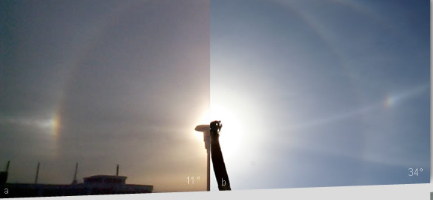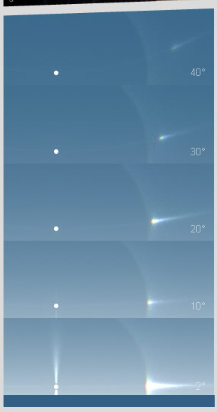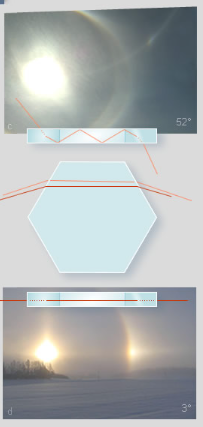Sundogs & Sun Altitude
Sundogs & Sun Altitude: Exploring the Phenomenon
Sundogs, also known as parhelia, are captivating atmospheric optical phenomena that occur when sunlight interacts with ice crystals in the atmosphere. These beautiful halo-like formations appear as bright spots on either side of the sun, typically at a distance of about 22 degrees. However, the positioning of sundogs in relation to the sun can vary depending on the altitude of the sun in the sky.
The Influence of Sun Altitude on Sundog Formation
The altitude of the sun plays a significant role in determining the appearance and position of sundogs. At sunrise and sunset, when the sun is near the horizon, sundogs are more likely to be observed at a distance of approximately 22 degrees from the sun. This positioning creates a stunning visual effect, with the sundog appearing close to the 22-degree halo that surrounds the sun.
As the sun rises higher in the sky, its altitude increases, resulting in a change in the positioning of sundogs. At higher altitudes, such as when the sun is around 34 degrees high, sundogs tend to be farther away from the sun than the 22-degree halo. This shift in distance is due to the path that sunlight takes through ice crystals at different altitudes.
Understanding the Interaction of Sunlight with Ice Crystals
When the sun is at a solar altitude of 0 degrees, sunlight passes horizontally through plate-like ice crystals, parallel to their upper and lower basal faces. Some of these rays get deviated by 22 degrees, which is the minimum deviation angle for a 60-degree ice prism. These deviated rays form the inner edge of low sun parhelia, contributing to the appearance of sundogs.
However, as the sun climbs higher in the sky, rays of sunlight must take skewed paths through the ice crystals. These paths become inclined to the basal faces of the crystals. Consequently, rays can no longer enter and leave the crystals at the minimum deviation angle of 22 degrees. As a result, the parhelia formed are located farther from the sun. The distance between the sundogs and the sun increases as the sun's altitude continues to climb.
Factors Affecting Sundog Brightness
The brightness of sundogs is influenced by the altitude of the sun. Sundogs tend to be at their brightest when the sun is low on the horizon. As the solar elevation increases beyond 40 degrees, it becomes more challenging to discern the vividness of sundogs. This decrease in brightness can be attributed to several factors, including:
- The increased path length of sunlight through the ice crystals as the sun climbs higher.
- The need for internal reflections within thin ice plates to allow skew rays to pass through.
- The requirement for an even number of reflections to form visible sundogs. An odd number of reflections can produce a sub-parhelion below the horizon.
Observing Sundogs: The Human Element
To truly appreciate the beauty of sundogs, one must witness them firsthand. Many individuals have contributed their observations and photographs to enhance our understanding of this phenomenon. Some notable names in the field of atmospheric optics include Brian Hartmann, Michael Pierce, Jim Kirk, and Erkki Polkolanen.
As with any natural phenomenon, sundogs can be elusive and require favorable atmospheric conditions to manifest clearly. Therefore, patience and persistence are key when attempting to observe and document sundogs. It is recommended to choose locations with unobstructed views of the horizon and clear skies for optimal viewing opportunities.
In conclusion, sundogs are captivating optical phenomena that are influenced by the altitude of the sun. As the sun rises higher in the sky, sundogs appear farther from the sun than the 22-degree halo. Understanding the interaction between sunlight and ice crystals provides insight into the formation and positioning of sundogs. The brightness of sundogs is at its peak when the sun is low, gradually diminishing as the solar elevation increases. By embracing the wonders of atmospheric optics and the contributions of dedicated observers, we can deepen our appreciation for the mesmerizing beauty of sundogs.

Sundogs are 22 degrees from the sun only at sunrise and sunset.
At left the sun is 11 high and the sundog is close to the 22 halo
At right the was higher at 34 and the sundog is father from the sun than the 22 halo.

At 0 degree solar altitude, rays pass horizontally through plate crystals and paralle to their upper and lower basal faces. Some are deviated 22, the minimum devaition anglefor a 60 ice prism, to form the inner (sunward) edge of low sun parhelia.
At higher sun, rays maust take skewed paths, inclined to the basal faces, to get through the cyrstal. No rays can enter and leave at the minimum deviation angle and the resulting parhelia are farther from the sun. Their distance increses as the sun climbs.
Skew rays mostly cannot pass through thin plates unless they are reflected between their upper and lower basal faces. Internal refelections may be needed even when the sun is only 10 high.
An even number of reflections are required. an odd number produces a sub-parhelion below the horizon.
Sundogs are at their brightest when the sun is low. At solar elevations much above 40 they are difficult to discer,.
a) Brian Hartmann
b) Michael Pierce
c) Jim Kirk
d) Erkki Polkolanen

Note: this article has been automatically converted from the old site and may not appear as intended. You can find the original article here.
Reference Atmospheric Optics
If you use any of the definitions, information, or data presented on Atmospheric Optics, please copy the link or reference below to properly credit us as the reference source. Thank you!
-
<a href="https://atoptics.co.uk/blog/sundogs-sun-altitude/">Sundogs & Sun Altitude</a>
-
"Sundogs & Sun Altitude". Atmospheric Optics. Accessed on November 26, 2024. https://atoptics.co.uk/blog/sundogs-sun-altitude/.
-
"Sundogs & Sun Altitude". Atmospheric Optics, https://atoptics.co.uk/blog/sundogs-sun-altitude/. Accessed 26 November, 2024
-
Sundogs & Sun Altitude. Atmospheric Optics. Retrieved from https://atoptics.co.uk/blog/sundogs-sun-altitude/.